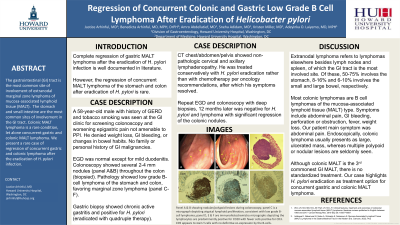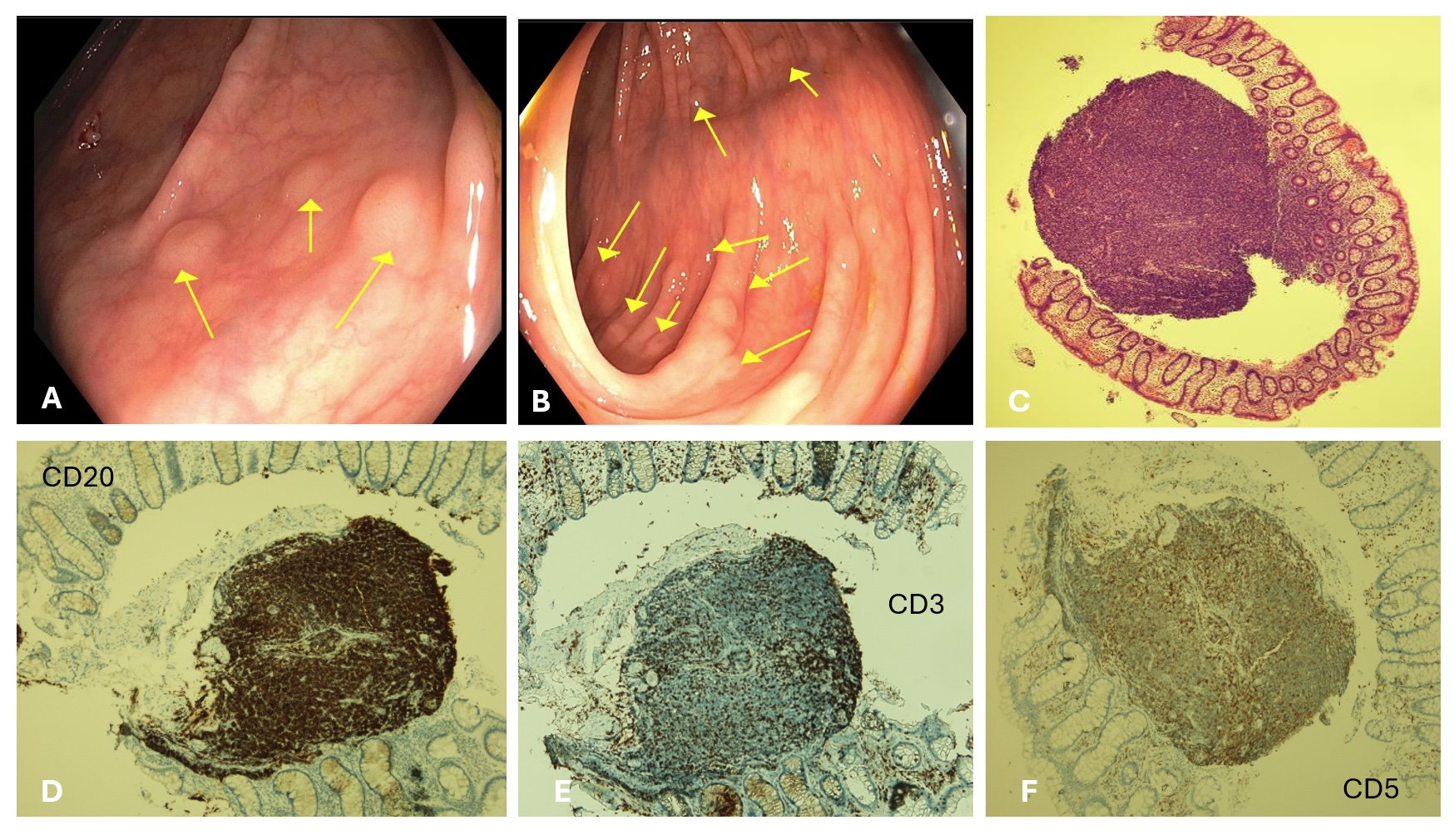Sunday Poster Session
Category: Colon
P0249 - Regression of Concurrent Colonic and Gastric Low Grade B Cell Lymphoma After Eradication of Helicobacter pylori
Sunday, October 27, 2024
3:30 PM - 7:00 PM ET
Location: Exhibit Hall E

Has Audio
- JA
Justice Arhinful, MD
Howard University Hospital
Washington, DC
Presenting Author(s)
Justice Arhinful, MD, Benedicta Arhinful, MD, MPH, DrPH, Sneha Adidam, MD, Amro Abdellatief, MD, Kristen Miller, MD, Adeyinka O. Laiyemo, MD, MPH
Howard University Hospital, Washington, DC
Introduction: The complete regression of extranodal low grade B cell gastric lymphoma after the eradication of Helicobacter pylori (H. pylori) infection is well documented in literature. However, the regression of low-grade B cell lymphoma involving the stomach and colon simultaneously after eradication of H. pylori is rare. We present a case of regression of low grade B cell gastric and colonic lymphoma after H. pylori eradication.
Case Description/Methods: A 58-year-old male with history of acid reflux and tobacco smoking was seen at the gastroenterology (GI) clinic for screening colonoscopy and worsening epigastric pain not amenable to pantoprazole. Three months prior, he had been seen in the emergency room with worsening epigastric pain and reflux symptoms for which he was prescribed pantoprazole. He denied weight loss, GI bleeding, or changes in bowel habits. No family or personal history of colorectal cancer or other GI malignancies.
He underwent upper endoscopy (EGD) and colonoscopy. EGD was normal except for mild duodenitis. Colonoscopy showed 2 - 4 mm nodules (panel A&B) throughout the colon, which were biopsied. Histopathology revealed low grade B cell lymphoma involving the stomach and colon, favoring marginal zone lymphoma (panel C - F); gastric biopsy showed chronic active gastritis and positive for H. pylori. H. pylori was eradicated with quadruple therapy. CT chest/abdomen/pelvis showed non-pathologic cervical and axillary lymphadenopathy. Hematology/oncology recommended no chemotherapy but rather to repeat EGD and colonoscopy after H. pylori eradication. After H. pylori eradication, his symptoms resolved and repeat EGD and colonoscopy with deep biopsies, 12 months later was negative for H. pylori and lymphoma.
Discussion: Extranodal lymphoma refers to lymphomas elsewhere besides lymph nodes and spleen, of which the GI tract is the most involved site. Of these, 50-75% involves the stomach, whereas 8-16% and 6-10% involves the small and large bowel respectively.
Most colonic lymphomas are B cell lymphomas of the mucosa-associated lymphoid tissue (MALT) type. Symptoms include abdominal pain, GI bleeding, perforation or obstruction, fever, weight loss. Our patient main symptom was abdominal pain. Endoscopically, colonic lymphoma usually presents as large, ulcerated mass, whereas multiple polypoid or nodular lesions are seldomly seen. In the case of concurrent gastric and colonic low grade B cell lymphoma, H. pylori eradication may result in the regression of both the gastric and colonic lesions.

Disclosures:
Justice Arhinful, MD, Benedicta Arhinful, MD, MPH, DrPH, Sneha Adidam, MD, Amro Abdellatief, MD, Kristen Miller, MD, Adeyinka O. Laiyemo, MD, MPH. P0249 - Regression of Concurrent Colonic and Gastric Low Grade B Cell Lymphoma After Eradication of <i>Helicobacter pylori</i>, ACG 2024 Annual Scientific Meeting Abstracts. Philadelphia, PA: American College of Gastroenterology.
Howard University Hospital, Washington, DC
Introduction: The complete regression of extranodal low grade B cell gastric lymphoma after the eradication of Helicobacter pylori (H. pylori) infection is well documented in literature. However, the regression of low-grade B cell lymphoma involving the stomach and colon simultaneously after eradication of H. pylori is rare. We present a case of regression of low grade B cell gastric and colonic lymphoma after H. pylori eradication.
Case Description/Methods: A 58-year-old male with history of acid reflux and tobacco smoking was seen at the gastroenterology (GI) clinic for screening colonoscopy and worsening epigastric pain not amenable to pantoprazole. Three months prior, he had been seen in the emergency room with worsening epigastric pain and reflux symptoms for which he was prescribed pantoprazole. He denied weight loss, GI bleeding, or changes in bowel habits. No family or personal history of colorectal cancer or other GI malignancies.
He underwent upper endoscopy (EGD) and colonoscopy. EGD was normal except for mild duodenitis. Colonoscopy showed 2 - 4 mm nodules (panel A&B) throughout the colon, which were biopsied. Histopathology revealed low grade B cell lymphoma involving the stomach and colon, favoring marginal zone lymphoma (panel C - F); gastric biopsy showed chronic active gastritis and positive for H. pylori. H. pylori was eradicated with quadruple therapy. CT chest/abdomen/pelvis showed non-pathologic cervical and axillary lymphadenopathy. Hematology/oncology recommended no chemotherapy but rather to repeat EGD and colonoscopy after H. pylori eradication. After H. pylori eradication, his symptoms resolved and repeat EGD and colonoscopy with deep biopsies, 12 months later was negative for H. pylori and lymphoma.
Discussion: Extranodal lymphoma refers to lymphomas elsewhere besides lymph nodes and spleen, of which the GI tract is the most involved site. Of these, 50-75% involves the stomach, whereas 8-16% and 6-10% involves the small and large bowel respectively.
Most colonic lymphomas are B cell lymphomas of the mucosa-associated lymphoid tissue (MALT) type. Symptoms include abdominal pain, GI bleeding, perforation or obstruction, fever, weight loss. Our patient main symptom was abdominal pain. Endoscopically, colonic lymphoma usually presents as large, ulcerated mass, whereas multiple polypoid or nodular lesions are seldomly seen. In the case of concurrent gastric and colonic low grade B cell lymphoma, H. pylori eradication may result in the regression of both the gastric and colonic lesions.

Figure: Panel A & B showing nodular/polypoid lesions during colonoscopy; panel C is a micrograph depicting atypical lymphoid proliferation, consistent with low grade B-cell lymphoma; panel D, E & F are immunohistochemistry micrographs depicting the lymphocytes are predominantly positive for CD20 with fewer cells positive for CD3. CD5 appears to stain T-cells with no definitive co-expression by the B-cells.
Disclosures:
Justice Arhinful indicated no relevant financial relationships.
Benedicta Arhinful indicated no relevant financial relationships.
Sneha Adidam indicated no relevant financial relationships.
Amro Abdellatief indicated no relevant financial relationships.
Kristen Miller indicated no relevant financial relationships.
Adeyinka Laiyemo indicated no relevant financial relationships.
Justice Arhinful, MD, Benedicta Arhinful, MD, MPH, DrPH, Sneha Adidam, MD, Amro Abdellatief, MD, Kristen Miller, MD, Adeyinka O. Laiyemo, MD, MPH. P0249 - Regression of Concurrent Colonic and Gastric Low Grade B Cell Lymphoma After Eradication of <i>Helicobacter pylori</i>, ACG 2024 Annual Scientific Meeting Abstracts. Philadelphia, PA: American College of Gastroenterology.

